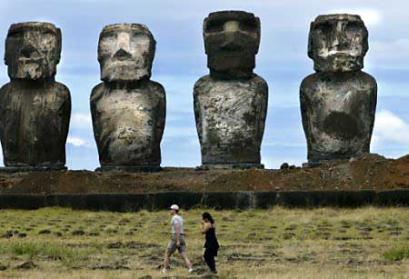11/19/2003:  Arcanum
Arcanum
Easter Island's Decaying Statues Await Facelift
By Ignacio Badal from Reuters
Caretakers of the cracked and crumbling Moai fret that a piece of history is deteriorating before their eyes.
"Something must be done immediately. If the Moai are destroyed, the island is destroyed because without tourism this island is nothing," said Rapa Nui expert Francesco Di Castri, former deputy director of the U.N. Educational, Scientific and Cultural Organization and former president of the World Science Institute.
But good news came in early November when UNESCO awarded German company Maar Denkmalpflege GmbH an $11.5 million contract to treat the statues with chemicals starting in 2005.
More
RANO RARAKU VOLCANO, Chile (Reuters) - The steep side of dormant Rano Raraku volcano is the most photographed spot on mysterious Easter Island.Tourists crowd each other to shoot photos of the statues called Moai in the native language. The enormous long faces of these best-preserved examples look down on their eroded brothers at outposts along the coast of Rapa Nui, as the island is known in the native language.
All of the existing 870 Moai sculptures were born here in a quarry of unique volcanic tuff rock.
The statues that were never moved from the quarry were protected from destructive rain, fire, animals, and souvenir grabbers that have destroyed other Moai and threaten to ruin the island's unique archeological treasure and tourism attraction.
The impassive charm of the Moai -- and the double mystery over the origin of the carvers and the engineering methods they used to move the statues -- draws 20,000 tourists a year, and $3 million in revenue, to this tiny triangle in the South Pacific, the most remote inhabited island in the world.
No one knows if the creators of these statues paddled to this 166-square-mile island from Polynesia, 1,800 miles away, or the even more distant mainland of South America.
And there are many theories but no facts about how the people who carved these statues 400 to 1,300 years ago moved monoliths up to 6 yards (6 m) tall and weighing up to 82 tons -- the equivalent of two sperm whales -- down the steep slopes of Rano Raraku to huge platforms near the shore, using only primitive tools.
Caretakers of the cracked and crumbling Moai fret that a piece of history is deteriorating before their eyes.
"Something must be done immediately. If the Moai are destroyed, the island is destroyed because without tourism this island is nothing," said Rapa Nui expert Francesco Di Castri, former deputy director of the U.N. Educational, Scientific and Cultural Organization and former president of the World Science Institute.
But good news came in early November when UNESCO awarded German company Maar Denkmalpflege GmbH an $11.5 million contract to treat the statues with chemicals starting in 2005.
The chemicals are meant to prevent moisture passing through the porous tuff and to stop the widening of large cracks that are now forming rapidly.
"It's great news. The important thing is to save the Moai," said Petero Edmunds, the mayor of the island, and promoter of the preservation plan.
The German project comes in addition to an ongoing $600,000 Japanese program to weatherproof some statues, including 15 well-known ones on the so-called Tongariki platform built by the Rapa Nui people from rock and earth at Anakena beach.
But some experts are taking a wait and see attitude on the German project, remembering broken promises of funds from other sources in the past.
"This type of project is often proposed with a total lack of knowledge about the conservation priorities here," said Francisco Torres, director of the island's archeological museum.
WEAKENED IN TRIBAL WARS
The ancient Rapa Nui people take the first blame in the history of damage to the statues, as they tore them down in tribal wars.
"Man was the first (to harm them), delivering them a big shock by toppling them," Torres said.
Wind, rain, earthquakes and tidal waves did further damage.
Europeans, who arrived on the island in the 1800s, hastened the deterioration, bringing sheep, horses and cows who stepped on and rubbed up against fallen statues and who still do so despite the fact that the figures are in a national park that protects most of the island.
In the 1900s tourists headed to the island and some broke Moai. Others were burned as the Rapa Nui cleared land with fire.
"It's impossible to control the animals and the people," said park guard Carlos Salinas.
But the park's caretakers are learning to get strict with tourists.
"Sometimes they (guards) go to far; they don't even let you stand close for a photo," complained a Spanish tourist at the 15 colossi on the Tongariki platform.
Monica Bahamondez, technical chief at Chile's National Conservation and Restoration Center, lamented on a visit to Easter Island that the Chilean government, which has total control over the park where the Moai stand, has not funded any preservation projects for the monoliths.
She would like to see the few funds there have been up until now focused on priority statues that are still worth saving.
"There are Moai that cannot be recovered, lying on the ground. If you pick them up they'll fall apart," she said.


